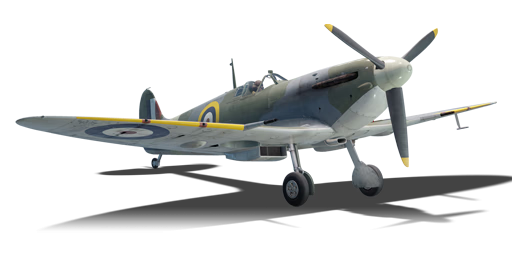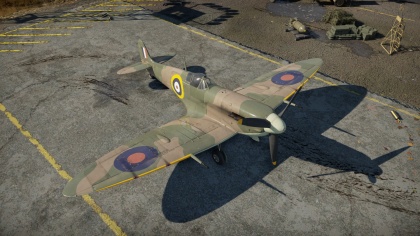Spitfire Mk IIb
Contents
| This page is about the aircraft Spitfire Mk IIb. For other uses, see Spitfire (Disambiguation) |
Description
The Spitfire Mk IIb is a Rank II British fighter
with a battle rating of 3.7 (AB/RB) and 3.0 (SB). This aircraft has been in the game since the start of the Open Beta Test prior to Update 1.29.
The Spitfire IIb is an excellent turn-fighter, and has excellent climb and speed characteristics - forming a middle ground between the sheer speed of the German fighters and American fighters and the nimble agility of the Japanese machines. These aircraft, however, have little in the way of armour protection - any hits will most likely damage something, and in addition, you will be helpless if you try to head-on something. Turn-fighting is the most efficient way of using this nimble, fast fighter, and it should be used in this way most of the time. A suggested loadout is to equip Tracers on the 7.7mm machine guns, and Stealth Belts on the 20mm cannons - this allows maximal amounts of damaging rounds - namely the Armour-Piercing Incendiary (AP-I), High-Explosive Fragmentation Semi-Armour-Piercing Incendiary (HEF-SAPI) and High-explosive Fragmentation Incendiary (HEF-I) Rounds. The technique to use this loadout will be described in the Usage In Battles Section.
Note, however, that with the two 20mm cannons, the Spitfire Mk IIb can also be used as a reasonable Boom and Zoom fighter with less results. It is recommended to maximize the use of AP-I ammo for the Spitfire Mk IIb's 7.7mm machine guns and the HEF-I ammo for the 20mm cannons for air damage. It is also advisable to make sure that you conserve your ammo and only fire when you have a clear target, as you'll find you'll run out of ammo very quickly. Sixty rounds of 20mm is not a very large ammunition pool, and will run out faster than the machine guns in most cases.
General info
Flight Performance
Describe how the aircraft behaves in the air. Speed, manoeuvrability, acceleration and allowable loads - these are the most important characteristics of the vehicle.
| Characteristics | |||||||
|---|---|---|---|---|---|---|---|
| Stock | |||||||
| Max Speed (km/h at 4,572 m) |
Max altitude (meters) |
Turn time (seconds) |
Rate of climb (meters/second) |
Take-off run (meters) | |||
| AB | RB | AB | RB | AB | RB | ||
| 545 | 535 | 10000 | 16.2 | 16.5 | 14.1 | 16.1 | 300 |
| Upgraded | |||||||
| Max Speed (km/h at 4,572 m) |
Max altitude (meters) | Turn time (seconds) | Rate of climb (meters/second) |
Take-off run (meters) | |||
| AB | RB | AB | RB | AB | RB | ||
| 599 | 571 | 10000 | 14.7 | 15.1 | 27.2 | 19.4 | 300 |
Details
| Features | ||||
|---|---|---|---|---|
| Combat flap | Take-off flap | Landing flap | Air brakes | Arrestor gear |
| X | X | ✓ | X | X |
| Limits | ||||
|---|---|---|---|---|
| Wing-break speed (km/h) |
Gear limit (km/h) |
Combat flap (km/h) |
Max Static G | |
| + | - | |||
| 760 | 270 | 290 | ~14 | ~8 |
| Optimal velocities | |||
|---|---|---|---|
| Ailerons (km/h) |
Rudder (km/h) |
Elevators (km/h) |
Radiator (km/h) |
| < 321 | < 400 | < 465 | > 260 |
| Compressor (RB/SB) | ||
|---|---|---|
| Setting 1 | ||
| Optimal altitude | 100% Engine power | WEP Engine power |
| 4,490 m | 1,140 hp | 1,311 hp |
Survivability and armour
- 38 mm Bulletproof glass in cockpit front.
- 4 mm Steel plate in pilot's seat
- 6-7 mm Steel plate behind the pilot.
- Critical components located at the front of aircraft (fuel, pilot, engine, controls)
- More fuel tanks located in wings near the fuselage
- Cooling systems heat up ridiculously fast
Armaments
Offensive armament
The Spitfire Mk IIb is armed with:
- 2 x 20 mm Hispano Mk.I cannon, wing-mounted (60 rpg = 120 total)
- 4 x 7.7 mm Browning machine gun, wing-mounted (350 rpg = 1,400 total)
Usage in battles
The Spitfire IIb is a very good turn-fighter, being one of the more agile aircraft in the game. It can reliably out-maneuver many of the aircraft in-game, and out-zoom-climb some as well. It has a very good rate of climb, adequate weapons, and machine-guns which can fire a copious amount of rounds and keep them on target. However, there are several things to be kept in mind while flying the Spitfire Mark IIb. These are:
- The relatively low amount of damage that the 7.7mm Browning machine guns put out
- The propensity of the 20mm Hispanos to jam after prolonged firing
- Lack of any armour on the engine and (relatively) small amounts of windscreen glass armour
- Proximity of vital systems towards the front of the aircraft.
- Lack of combat flaps
- Increased efficiency of control surfaces (ailerons, elevators, rudder) at medium speeds (300km/h-400km/h) and engine efficiency at low altitudes (below 4000m)
- Inability to hold WEP for long before the engine begins overheating
This fighter, unlike American and German fighters, is neither a gun platform, nor a potent Boom-and-zoom fighter. It will not be able to hold its top speed for very long due to its lacking cooling systems unless the radiator is forced open by MEC - and even then, the extra WEP time provided isn't much. In addition, the aircraft is unable to deploy combat flaps, which means you cannot have 'reserve maneuverability' to out-turn a fighter in order to retreat.
Nation-specific points to keep in mind while flying these fighters against are:
| Disclaimer: This is a very general guide to the aircraft's capabilities. Following these to the letter without consideration of the enemy's abilities can still lead to a loss. |
- Japanese Fighters - Japanese fighters are more nimble than you. If you enter a turn-fight with them, and the pilot is smart, he or she can and will deploy their combat flaps and shoot you down.
- American Fighters - At this rank, you will be facing US fighters such as the F4F (the wildcats), the P-47 (the Thunderbolt), and many other aircraft which have 0.50-caliber machine guns. These large-caliber machine guns will shred a Spitfire to pieces if given the opportunity to fire a long, sustained burst at you, such as in a head-on engagement.
- German/Italian Fighters - German and Italian fighters will usually have cannons and hold a speed advantage over you, as well as being more capable at higher speeds and altitudes. If you head-on a German fighter, you will lose over 90% of the time, unless you are lucky and manage to land critical hits on the engine and the pilot - and this is also unlikely given that the 7.7mm machine guns are not known for their armour-piercing abilities.
- Russian Fighters - Russian fighters will have cannons, large-caliber machine guns, or both, in conjunction with small-caliber guns. Again, facing these head-on is suicide, and at the low altitudes you will meet them at, trying to use speed to out-zoom them is suicide. Turn-fighting may be optimal in these situations, but keep in mind that some Russian fighters are very, very maneuverable at low altitudes.
Manual Engine Control
| MEC elements | ||||||
|---|---|---|---|---|---|---|
| Mixer | Pitch | Radiator | Supercharger | Turbocharger | ||
| Oil | Water | Type | ||||
| Controllable | Not controllable | Not controllable | Not controllable | Separate | Not controllable | Not controllable |
Modules
| Tier | Flight performance | Survivability | Weaponry | ||
|---|---|---|---|---|---|
| I | Fuselage Repair | Radiator | |||
| II | Compressor | Airframe | |||
| III | Wings Repair | Engine | |||
| IV | Engine Injection | Cover | |||
Pros and cons
Pros:
- Absolutely amazing turn capabilities, even at low speeds.
- One of the best turners.
- Superior climb capabilities.
- Relatively good armament with a 20 mm and 7.7 mm combination arrangement.
- Very easy aircraft to control.
- Good acceleration.
Cons:
- 7.7 mm machine guns have low damage and stopping power.
- Cannons have average ammo count for this rank.
- Wings overload easily at high speeds.
- Hispano Mk.I 20 mm has a tendency to jam under continuous firing.
- Low dive speed limit.
- Poor roll rate, especially at high speed.
- Poor high-altitude performance (compared to lower altitudes)
- Engines easily overheat.
- Only position for flaps is in landing mode.
History
The Supermarine Spitfire was a British fighter which served with various nations from the late 1930s up into the 1950s. It was a single-engine, all-metal, low-wing monoplane with retractable landing gear. Various modifications served as fighters, interceptors, high-altitude fighters, fighter-bombers and reconnaissance aircraft. A total of some 20,300 Spitfires of all types were built during the war, including two-seater trainers.
In the summer of 1939, an early Spitfire Mk I was fitted with the new Rolls Royce Merlin XII engine, which had a higher output of 1175 HP and was fitted with a Coffman engine starter instead of the previous Merlin’s electrical starter system. This, combined with the Rotol variable pitch propeller which had been used on many Spitfire Mk Is would now form the powerplant of the new Spitfire Mk II, although some production models used the De Havilland propeller. The Mk II was some 6-7 mph faster than the later Spitfire Mk I, but still slower than the original Spitfires before a series of modifications increased the aircraft’s weight. As with the Mk I, the Spitfire Mk II was produced with either eight machine guns as the Spitfire Mk IIA, or two 20mm cannon and four machine guns as the Mk IIb. The earlier problems with cannon fitted to the Mk IB had now been solved by introducing a belt feed system to the weapon to replace the earlier drum, turning the cannon on its side and fitting a blister on the wing to house the new mechanism.
920 Spitfire Mk IIs entered service; 750 Mk IIA and 170 MK IIB, although fighters used in the air-sea rescue role were later designated Mk IIC. The Spitfire II quickly replaced the Spitfire I, with the older variant being relegated to use in Operational Training Units. By April 1941, RAF Fighter Command had completed re-equipping with the Mk II, although this too would soon be replaced by the Mk V.
Media
Excellent additions to the article would be video guides, screenshots from the game, and photos.
See also
Links to the articles on the War Thunder Wiki that you think will be useful for the reader, for example:
- reference to the series of the aircraft;
- links to approximate analogues of other nations and research trees.
External links
Paste links to sources and external resources, such as:
- topic on the official game forum;
- encyclopedia page on the aircraft;
- other literature.





